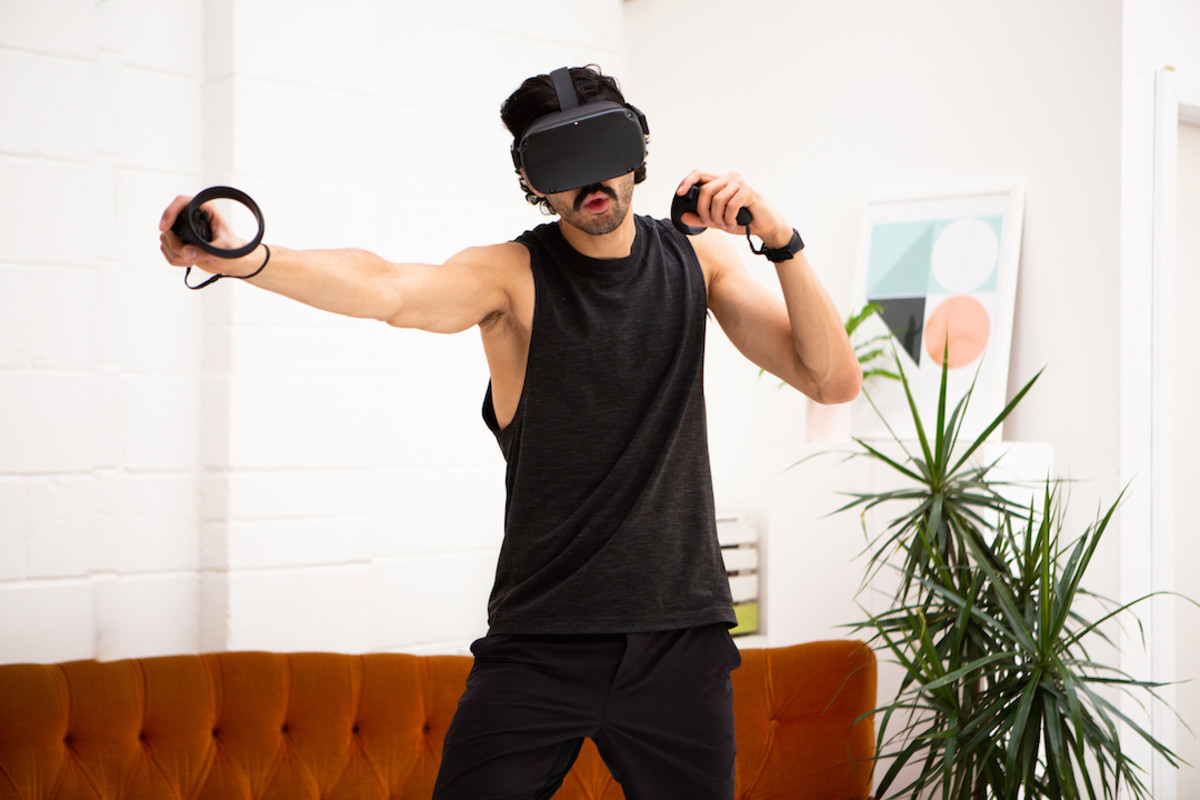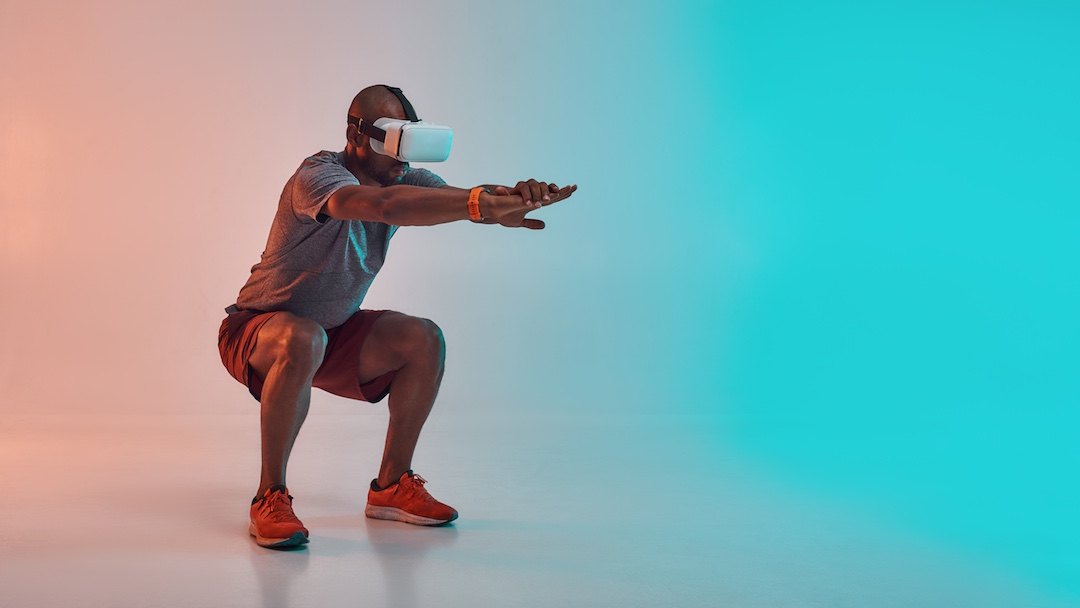No products in the cart.
Fitness Tips
VR Fitness Is a Serious Workout, Seriously
In the last days of 2020, Oculus quietly rolled out a fitness tracker, called Oculus Move, that lives inside its Quest headsets. Users who download the software can watch the calories they burn in virtual reality, along with their physically active minutes, climb on a ticker floating above or below their field of view. With a deeper dive into the tracker’s dashboard, they can also set goals and track their progress over time.
Move appears to be an acknowledgment from Oculus that fitness is a primary reason for many people to use VR. That’s certainly the case for me. I’m not much of a gamer in general, but for the past couple months, I’ve exercised nearly every day in virtual reality. And despite what you might think about the incompatibility of video games and exercise, these are serious workouts. Some end with me gasping for breath and wringing sweat from my beard.
In that sense, VR has saved me from bodily neglect. It’s helped me grasp the motivation that’s been threatening to slip through my fingers since the start of this godforsaken pandemic.
During the spring, summer, and fall seasons of COVID, I managed a couple 20-mile bike rides each week. On weekends I occasionally found strength for longer rides, and on one hot Saturday, I logged 100 flat miles on Long Island. But it was always a struggle to get moving, and as winter arrived in New York, my rides petered. After a couple inactive weeks, I decided to see what I could accomplish inside a Quest 2 ($299), the entry-level headset Oculus released in October.
Initially my plan was to use VR for a few minutes of movement on particularly cold days. But then I started building a library of games and programs, some of which I considered warm-ups that helped vault me into more serious cardio. Now, every day, I piece together a workout based on my mood and energy level. Video games are part of my daily routine, and I feel lazy without them.
What does a VR workout look like?
There are dozens of virtual reality programs you can use to burn a few calories, but as of now, there are only a few specifically focused on exercise. By far my favorite is the subscription-based program Supernatural ($19/month, or slightly less for annual memberships).
Workouts typically run 10- to 30-minutes, and they roll out fresh daily. After a quick stretch with a trainer, music kicks on and triangles and targets begin flying toward you. Your job is to squat through the former and smash the latter with the virtual batons in your hands.

It’s simple enough, but the game moves fast, especially with workouts labeled “hard.” You’ll struggle to hold a squat inside a triangle tunnel that forces you to stay low while swinging your arms. Then you’ll explode upward to swat an overhead target, side-lunge left then right to thread the off-kilter scalene triangles, and then attack a dozen more targets before dropping back down into a squat.
The movements burn, but they don’t immediately register as exercise. Not in the strictest sense, anyway, because Supernatural feels more like a sport than a workout. You run your score up by hitting targets, and with more powerful swings, you amass more points. You can track your progress on a leaderboard, and if you want to jump the person ahead of you, you’ll either have to work harder or longer.
To help break the monotony of exercise, each workout takes you around the world. You might start out on an arctic tundra, move to the edge of an Egyptian pyramid, and then end on the lip of a volcano in Ethiopia.

And each location pairs with a new song, which dictates the intensity of the workout. Supernatural invests heavily in licensing fees, and its programmers have delightfully diverse tastes. I’ve worked out to hip-hop, Southern rock, top 40. Some particularly motivating tracks have come from the New York Dolls, Violent Femmes, Kendrick Lamar, and one Skrillex track that threatened to detach my arms from my body.
The other program I use often is FitXR ($29.99), which fills my urge for head-to-head competition. With each workout, six other VR users join me. They appear as silhouettes to my left and right, and I do everything I can to make sure I score more points than they do.
FitXR workouts come with less novelty than Supernatural’s—there are only two environments, and the music isn’t anything I recognize. But it does offer workout variety, with either boxing or cardio dance classes. I prefer the former, which much like Supernatural, functions with moving targets set to the beat. Only this time, you’ll have to toggle between jabs, crosses, hooks, and uppercuts, depending on the target.

A streak counter tells you how many consecutive targets you’ve hit, and a power meter gives you a real-time score on each punch. Both metrics—accuracy and power—play into your position on the leaderboard.
The cumulative effect of scorekeeping and instant feedback available in both Supernatural and FitXR amount to what researchers call gamification. “You’re earning awards and leveling up,” says Tumay Tunur, Ph.D., a kinesiologist who studies virtual reality at California State University San Marcos. “It’s very rewarding, and it definitely helps with adherence.”
Consistency, says Tunur, is the most critical component of any workout routine. And that’s what makes gamification potent: It gives you goals that numb the pain, and it keeps you coming back for more.
Tunur’s VR fitness game of choice is the rhythm-based Beat Saber ($29). “When I play, I’ll say, ‘I’m gonna go in for 20 minutes to get a quick workout,’” she says. “Then 40 minutes later, I’m still playing.”
I can relate. When I’m feeling lethargic, I delay my serious workout by playing a first-person shooter like Pistol Whip ($24.99) or scaling cliffs in The Climb ($29.99). Both games get my blood pumping, and after a couple rounds, I’m eager to log in to Supernatural or FitXR.
According to Oculus Move, the built-in tracker, I’m burning 200-400 calories per workout, and in one 49-minute session, I clocked 549. I suspect the numbers are inflated, however. I’ve worn both Garmin and Fitbit trackers during my VR workouts, and they registered 24 percent and 35 percent lower, respectively.
But I don’t particularly care about calories. The more important metric for me is exertion, and the trackers told me I was keeping my average heart rate close to 130, with a peak near 170. Those are legitimate numbers, and they provide context for research on VR fitness.
Last year, kinesiologists at the University of Minnesota reviewed 15 studies on the subject. Among those that looked at physical outcomes such as body composition, fitness level, and muscular strength, two-thirds showed positive results from VR workouts. And that’s despite relatively short study periods and outdated technology. (The oldest study in the analysis is from 2003, which is ancient in tech years.)
But perhaps the more interesting finding comes from the studies that looked at VR’s psychological effects. According to the research, virtual workouts can reduce fatigue and symptoms of depression.
Again, I can relate. Virtual reality isn’t reality, but it does transport me somewhere outside my apartment. That’s valuable given that my local restaurants, bars, and gyms are all inaccessible due to the pandemic. VR is a small bright spot—a healthy one, at that—in what could otherwise feel like a yearlong, pandemic-induced Groundhog Day.
Virtual workouts and the future
If you’ve been paying attention to VR, then you’ve been hearing for a decade that Oculus was on the verge of making the technology mainstream. So what’s different about now? That’s easy: Accessibility.
Until recently, affordable consoles were just plastic or cardboard holsters that strapped a smartphone to your head. There wasn’t much you could do with them. And even today, high-end goggles require cables to keep you tethered to an expensive gaming computer.
The Oculus Quest, released in 2019, was the first to bridge the divide. It was wireless and had a $399 price tag. It wasn’t cheap, but it wasn’t four-figures expensive, either. And 17 months later, Oculus released the Quest 2, an update that improved significantly on the visuals (frame rate and resolution are both higher), weight (it clocks in at just over one pound), and price ($299). It stands to reason that as the technology continues to improve, so will the fitness applications.
My one overarching complaint of the Quest 2 comes not from Oculus, but from its parent company, Facebook. With the second-generation console, the social-media company began requiring its virtual-reality users to log in using a Facebook profile.
That probably won’t phase the site’s billions of active users, but I deleted my account a couple years ago. Facebook found a way to force me back on, and the strong-arm mandate confirms my suspicion that it cares more about harvesting my data than winning me back as a loyal customer.
Regardless, VR fitness has officially landed, and I’d wager that goggles will soon be as common as treadmills.
Consider Holodia, a company that began making VR workout software in 2018. Originally, Holodia targeted gyms with virtual jungles and rivers that members could accelerate through using rowing machines, ellipticals, and exercise bikes. But in January, Holodia launched a subscription-based program for the Quest 2, presumably to jump on the at-home VR fitness trend.
Users can run the program, called Holofit ($10.75/month, less for longer memberships), using smart rowing machines or bikes and ellipticals with cadence sensors attached. But more tellingly, they can now also run it by doing crunches or jogging in place—no heavy equipment required.
That seems to provide a clue to where VR fitness is headed. While it began as a novelty, it’s now capable of serving as the centerpiece to your home gym. It costs less, takes up less space, and incentives you with game-like elements and daily updates.
Truth is, I don’t always feel like working out. But these days, I’m always down for a break from reality. It’s wonderful that VR can offer both.
For access to exclusive gear videos, celebrity interviews, and more, subscribe on YouTube!
Source link

